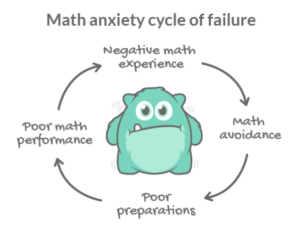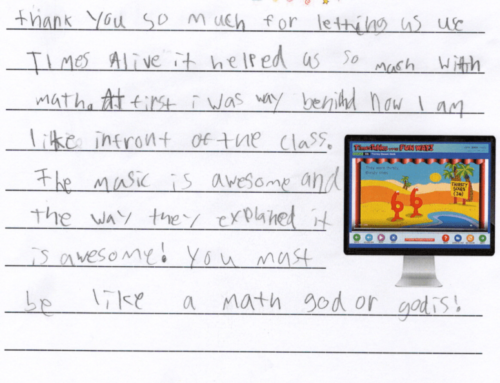We have all experienced math anxiety at some point in our lives.
That moment in your childhood classroom where you stared at a page full of symbols and numbers, pencil gripped so tightly your knuckles changed color while you wracked your brain for answers you felt like you should know but just couldn’t remember.
What a horrible feeling! And yet, for so many kids today this anxiety is part of their daily life.
Anxiety is a common response to math, and it’s not just limited to kids. In fact, 93% of adults experience some type of negative reaction – ranging from apprehension and tension to more physical symptoms like an elevated heart rate or upset stomach – that interferes with their ability to solve mathematical problems.
Why the Anxiety?
So what is it about math that makes us (and kids) feel so much anxiety?
Well, there’s a few reasons why the thought of mathematics can elicit a negative response in students – do any of these sound familiar?
- A student in your class doesn’t fully understand their multiplication concepts, but you have to keep teaching new math to stay on track for the year.
- Your student has trouble remembering concepts that were covered weeks ago but haven’t been reviewed. They don’t really have recall of previously taught content.
- A student has a learning disability and memorizing facts doesn’t seem to click. If anything, it serves to highlight the challenges they deal with. Rote memorization of random numbers just isn’t working.
Once a child loses confidence in their ability to understand or apply math concepts, the pact of anxiety is a downward spiral that leads to failure. They can easily start to focus on their negative inner dialogue instead of what they know. This onslaught of negative self-talk can actually cause working memory overload.
As these types of thoughts fill their minds, their brains experience a surge in adrenaline and a decrease in working memory, leaving them more likely to make errors, blank out on the answers they do know or choose to avoid the subject altogether.
Effects of Anxiety
Of course there are obvious short-term effects of math anxiety, like physical response, decreased reading comprehension and loss of mathematical cognition. But there are pretty serious long-term consequences at stake if math anxiety is not managed.

Math anxiety, and not mathematical ability, is directly linked to avoidance of and underperformance in STEM domains. And outside of a student’s individual performance, a parent or teacher’s feelings of anxiety toward math can influence a child’s feelings toward the subject itself.
It’s pretty easy to spot a student experiencing math anxiety in the moment. None of us wants to see the children we are teaching fear making mistakes to the point they develop an unwillingness to even try. But how do you keep a kid from shutting down, checking out and falling into a deeper cycle of failure?
How do you break the anxiety cycle?
One strategy is to continue using the same methods for teaching – rote memorization, lots of timed tests, fact-based learning that doesn’t engage multiple senses. But surely there has to be a better way.
“The math classroom that prioritizes rote memorization, meaningless algorithms, and speed must become a relic of the past…” states Shelby Strong in a recent Edutopia article on math anxiety.
If that’s the past, what is the future?
A Different Approach
A Scholastic article addressing math anxiety in kids pinpoints some common problems and the solution-based responses that help dissipate negative feelings toward math and build a sense of excitement at “learning from their mistakes in math instead of fearing them.”
The solutions include:
- Cultivating a growth mindset
- Building on from a student’s comfort level
- Allowing for multiple pathways to arrive at the answer
- Focusing on problem-solving instead of speed
- Making math a game
The article points out that “teaching in a way that cuts math anxiety” leads to increased engagement from learners. And when kids feel like they’re having fun, they are less likely to remember the fear or anxiety they feel about math.
Using story- and game-based resources provides opportunities for kids to learn and practice concepts in a very low-stakes way. The idea of gamification isn’t new, but it continues to gain traction as its effectiveness is studied and seen in the classroom.
Gamification serves to make hard stuff seem more fun, increases student engagement and helps them absorb and apply the information they’re learning as they interact with the game or program.
Game-based elements that can help engage and motivate learners include using narratives (or stories), providing immediate feedback, providing opportunities for them to build or ‘level up’ their mastery of a concept, giving progress indicators and letting the player have control of what they do.
Finding the Right Resources
If your child or student is struggling with math anxiety, looking for narrative-driven, game-based programs to help them learn could be your best next step. As a child engages with story-based content, they are able to retain facts that don’t stick by rote memorization alone.
Using a computer program allows them to take control of their own learning, and they are given visible indicators of their progress which encourages them to continue on. A multi-sensory program that utilizes story, video, song and games can be incredibly effective for all learners, including those who have learning barriers such as math anxiety, dyscalculia or ADHD.
Times Alive, the online computer program modeled after Times Tables the Fun Way, provides an engaging and story-based way for kids to learn and remember their multiplication facts. It focuses on a narrative approach reinforced by songs and games, and allows users to see their improvement and cognition over time.
Math anxiety is real, but the solution to conquering it may be as simple as bringing fun back into learning. Utilizing narrative-driven, gamified resources with kids who feel stressed about math can help bolster their confidence and help them retain information they couldn’t before. And that makes all of us winners!
For more information on Times Alive, click here.
A note from a Times Tables the Fun Way customer:
“The times tables program was the best thing for my daughter. She went from frustrated to successful in a month. It was amazing! Her teacher called me and asked what program she was using because the impact was so profound.” Dana Rickers, Grandville, MI







Leave A Comment